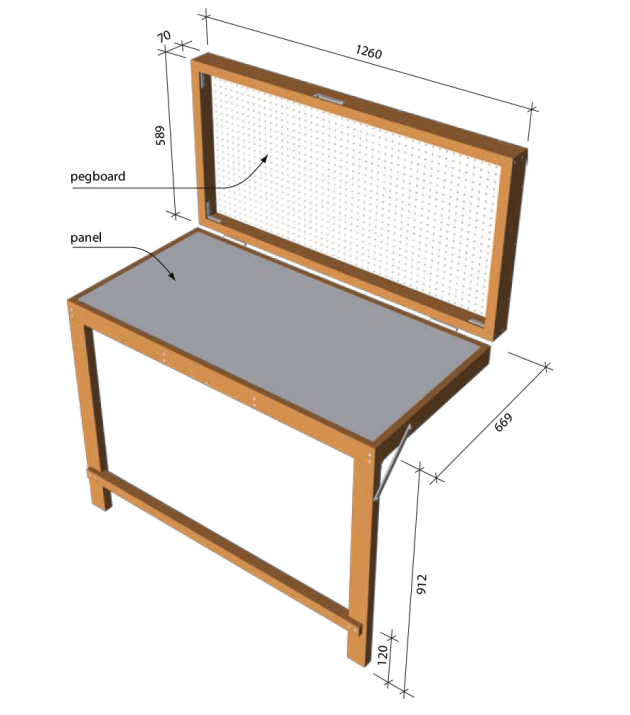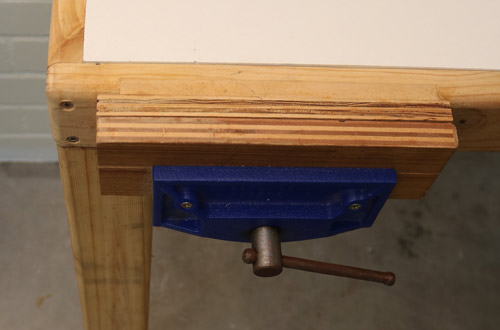Foldaway Bench
Words and photos: Kerryn Carter
Diagram: Graham Sands
I arrived at my brother’s house, went straight to the one corner of the garage that wasn’t filled with golf clubs and baby gear to see my father, John Dixon, hunched over in work mode position. He was busy installing what looked to be his version of the much loved fold-down workbench.
I asked him what it was. He said ‘It’s the MacGyver bench’. He gave me a wink and I took the bait, ‘Okay, what’s that?’. ‘It’s so when I come to Sydney and visit your brother I have something to fix just about anything. And the whole thing folds up to nothing.’ And with that he happily resumed his installation.

My father was always a man of action who loved his workshop. He entered into working life via the BHP blast furnaces in Newcastle as a boilermaker. He was solid and muscular, not from hours at the gym, but from years of industry. At the very core of his soul was a desire to make and when he wasn’t making he was helping others make. After years at BHP he left to join the ranks of other unsung heroes who teach wood and metalwork in our schools.
He never graced the pages of Wood Review magazine with his work although almost certainly some of his students have. While his output and standards were remarkably high he would humbly never have believed his work to be good enough. He spent his life making the lives of his family (including me) and friends better by fixing things or making them things they needed or could not otherwise acquire.

I’d classify his taste as Shaker minus the spindle back chair. He certainly liked clean lines and let the beauty of the wood speak for itself. He had a passion for Tasmanian oak, so our house became a shrine to the species so-named.
It was an endless procession of hall tables, entertainment cabinets, coffee tables and side tables and because he was a metalworker, there were wrought iron artworks, security doors and steam engines to name a few. Being able to work both wood and metal is empowering and patent to every visitor to our house.
My father died within months of installing his ‘MacGyver’ bench in my brother’s house. I was paralysed by grief at his passing. He left us and many other people with his beautiful furniture and of course a workshop packed full of machines, jigs and tools but I often came back to his MacGyver bench. This represented something important to me because I saw it as his first lesson for me in what is a good basic workbench and tool assortment. There are certainly many iterations of this kind of foldaway workbench but I still like this one because it’s small and simple.
The MacGyver Bench is essentially two almost identical hinged frames. The top frame attaches directly to the wall and the workbench frame is supported by hinged legs. The beauty of this design is obviously that your tools are stored in your bench, which is itself foldaway.

Top frame
The top frame that houses the pegboard and tools is a simple mitred frame (reinforced with screws and angle brackets) with a rebated rear that holds a 16mm thick melamine panel (can be plywood). The melamine panel is held in by screws and attaches directly to the wall with four long lag screws on washers.
The pegboard rests on battens which are screwed onto the melamine panel. The top frame is also supported underneath via a rail which is independently dynabolted into the wall. In order to accommodate tool storage, the top frame is made of 89mm pine which is thicker than the workbench frame which is just 70mm pine.

Workbench frame
The 70mm thick workbench is a lap-jointed frame (reinforced with screws) which is rebated to hold another 16mm melamine panel. The melamine panel is also supported underneath by two cross rails which are screwed both into the workbench frame from the side and from underneath up through the melamine panel.

The pine legs are 70mm wide and are braced with a lap jointed support rail.

Side brace and top latch
My father made his own side leg locking brace out of aluminium and a rivet. You can buy side braces from most hardware stores if you don’t want to make your own. The top latch is easily manufactured using a drill and aluminium sheet and some screws.
Kerryn Carter teaches woodwork classes for women and kids in Sydney. See toolschool.com.au



